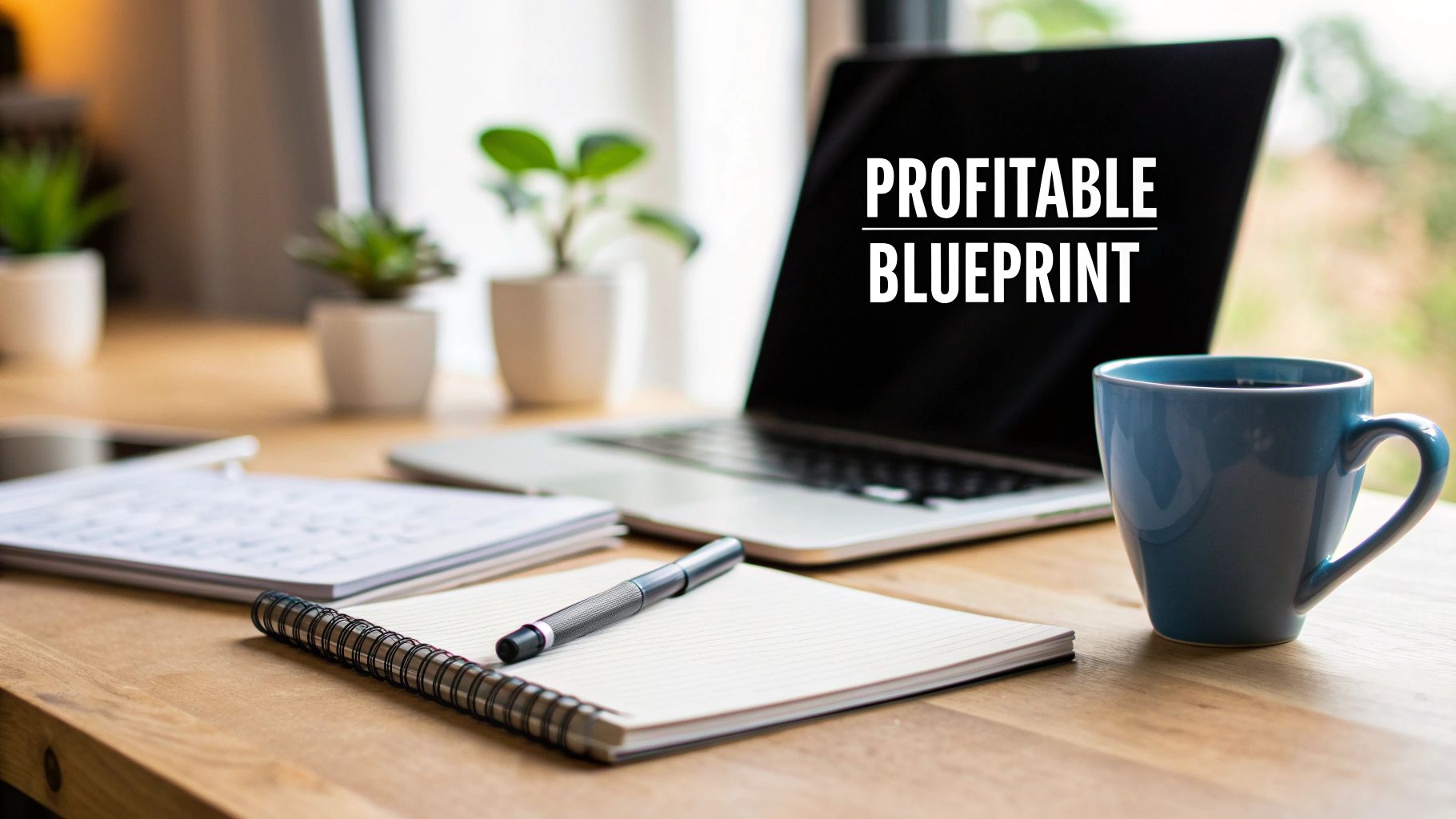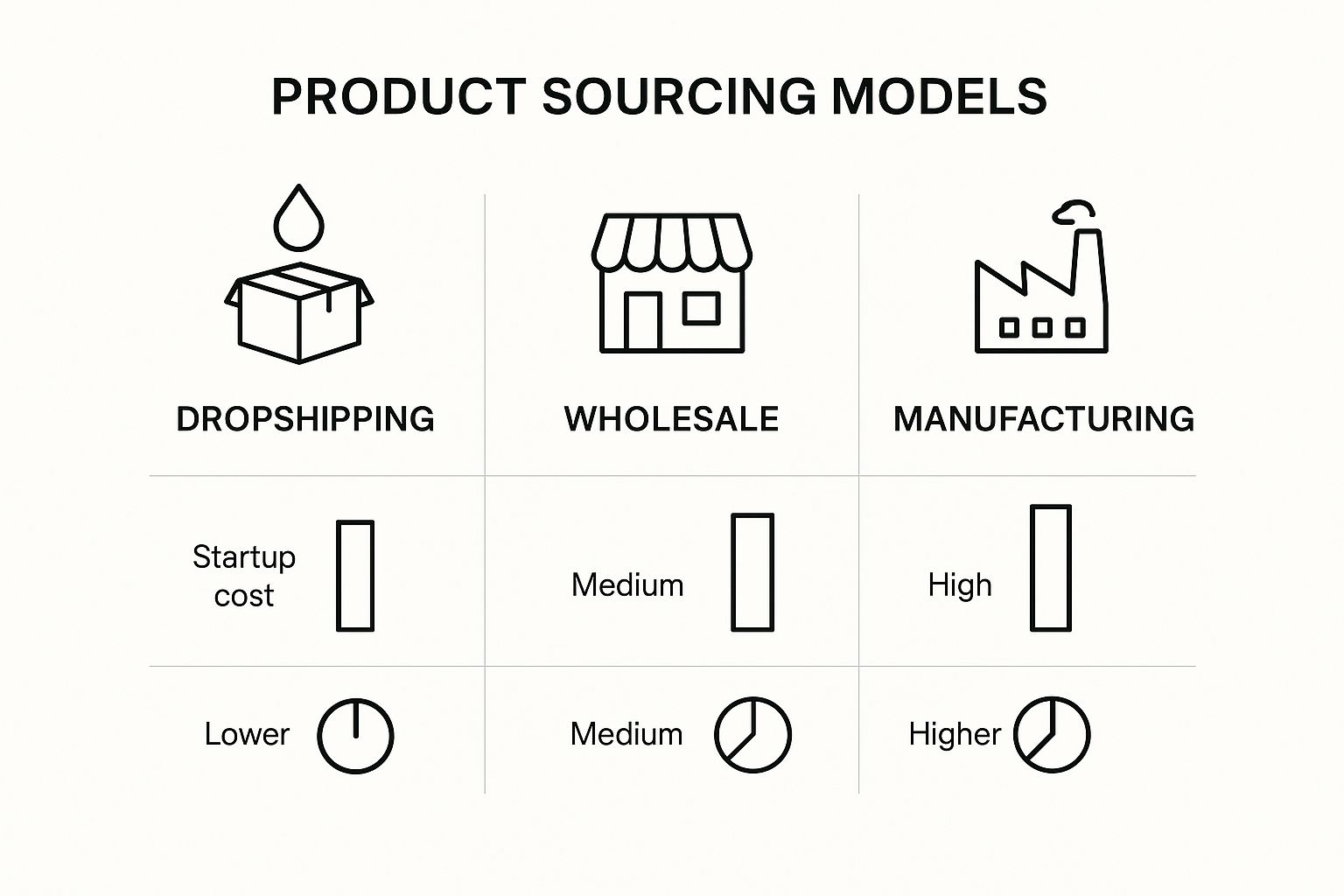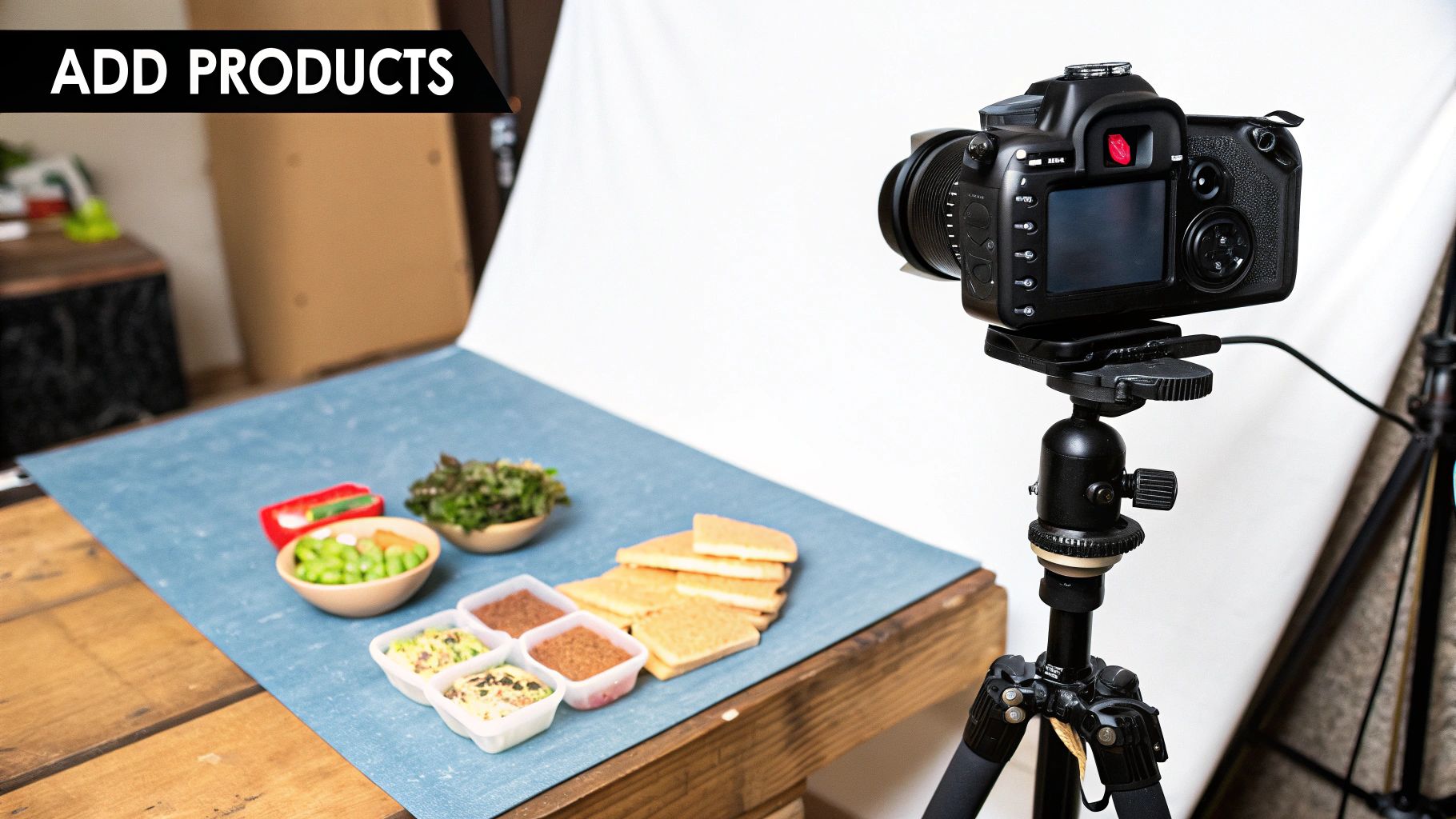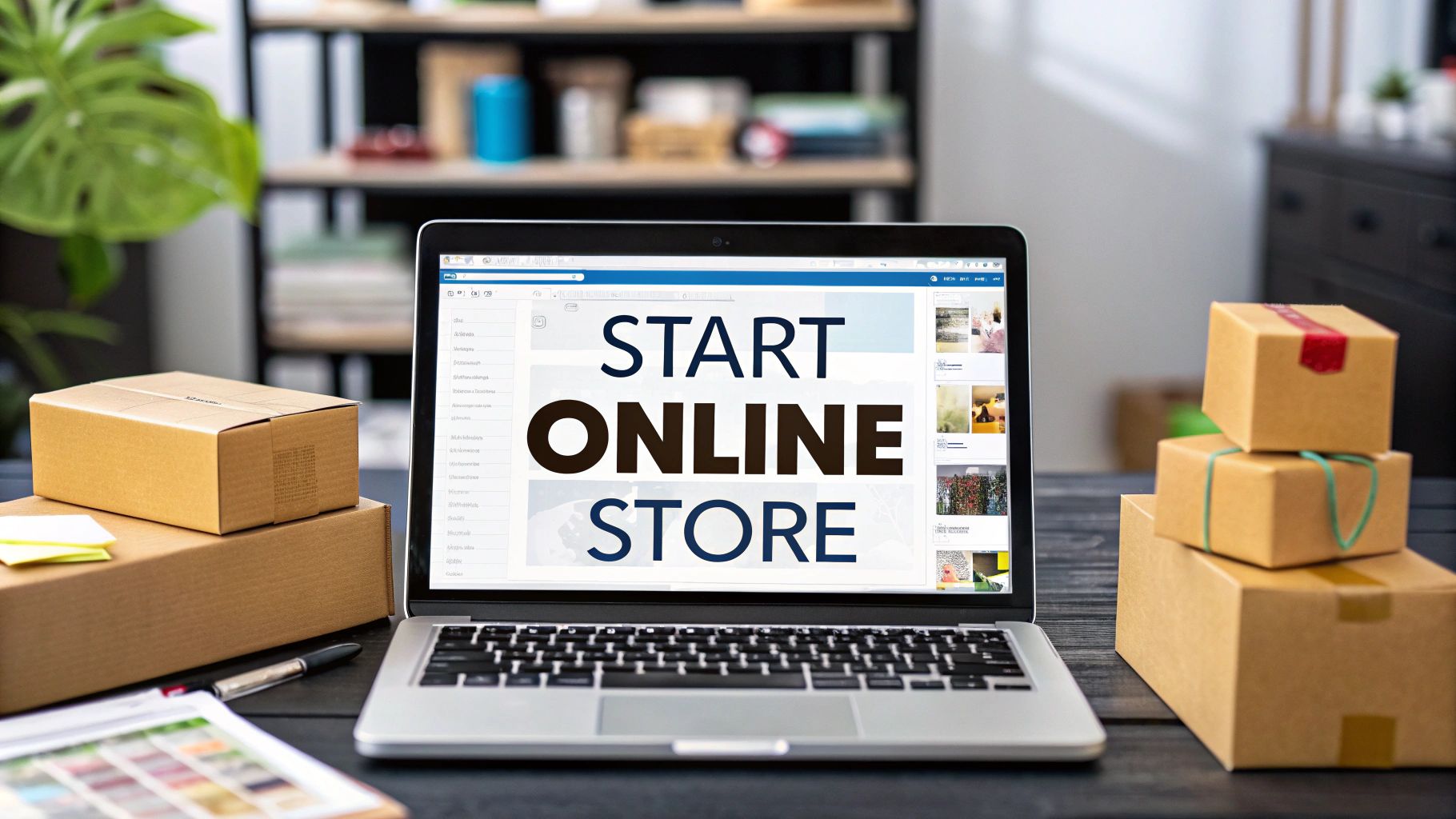
So, you want to build an online shop. Fantastic. The first step isn't choosing a fancy name or designing a logo. It’s about creating a solid plan that maps out your target customer and your strategy before you even think about hitting ‘publish’.
Your Framework for a Profitable Online Shop That Succeeds

Let's be honest, starting an online shop that succeeds is less about one amazing idea and more about getting the boring-but-essential stuff right. So many new entrepreneurs jump straight into picking a colour scheme before they've even worked out if anyone will actually buy their product. A solid framework stops you from doing that by making you answer the hard questions first.
Think of it like building a house. You wouldn't order a sofa before you have the blueprints drawn up, would you? Your e-commerce blueprint is a simple business plan that details exactly who you're selling to and how you’re going to do it.
Defining Your Business Foundation
Before a single pixel of your website is designed, you need to validate your core idea. This is where you move from a vague concept to a focused business model. A good, comprehensive guide on how to start an ecommerce store can be a brilliant launchpad for this stage.
Your first moves should be:
Validating Your Idea: Is there a real demand for what you want to sell? A great way to check is by actually talking to potential customers. Dive into forums like Reddit and see what problems people are trying to solve.
Identifying a Profitable Niche: Don't just sell "clothes." Think more along the lines of "sustainable workout gear for new mums." A tight niche helps you stand out in a ridiculously crowded market and makes your marketing laser-focused.
Defining Your Target Customer: Get to know your ideal customer inside and out. Create a detailed profile—what are their interests, what keeps them up at night, and where do they hang out online? Every single decision you make from here on out should be with this person in mind.
Crafting Your Initial Strategy
Once you know your niche and your customer, it’s time to sketch out your strategy. This doesn't need to be a 50-page beast of a document; a simple outline is all you need to get started.
One of the biggest mistakes I see is people expecting instant success. Building a profitable online business takes time and consistent effort. Focus on a solid foundation, then make small, steady improvements based on real customer feedback.
Your strategy outline should cover three key areas:
Product Sourcing: How are you getting your products? Will you be making them yourself, buying from a wholesaler, or using a dropshipping model? Each path has completely different costs and operational headaches.
Pricing Structure: Time to do the maths. Calculate all your costs—the product itself, platform fees like Wix, marketing spend—to set a price that actually leaves you with a profit. And please, don't forget to see what your competitors are charging.
Launch Plan: How are you going to tell the world you exist? A simple pre-launch plan could be building some buzz on social media or starting an email list with a "coming soon" page.
By focusing on this framework first, you’re creating a clear roadmap. This initial planning means that when you’re ready to build your site on a platform like Wix, you’re not just making a pretty shop—you’re building a business that’s actually set up for growth.
Ready to get started? Grab a notebook, and let's turn that vision into a real plan.
Finding Your Niche and Sourcing Products
Before you spend a single penny on web design or platform fees, the real work begins. Honestly, your online shop's success hinges on two massive decisions: what you sell (your niche) and how you get it (your sourcing model). Nail these, and you're building on solid ground.
Choosing a niche isn’t about limiting yourself; it’s about focus. Instead of shouting into the void trying to appeal to everyone, you’re targeting a specific group of people with a specific need. This makes your marketing laser-focused and helps you stand out in what is, let's face it, a very crowded marketplace.
Uncovering a Profitable Niche
A great niche sits at that sweet spot where your passion, customer demand, and profitability all meet. Don't just guess what people want; do some proper digging to validate your ideas and find those juicy gaps in the market.
Start by lurking in online communities where your potential customers hang out. Subreddits, Facebook groups, and industry forums are absolute goldmines. Pay attention to the problems people are moaning about, the products they rave about, and their frustrations with what’s already out there. This is where you'll find genuine, untapped demand.
Try these practical research tactics:
Analyse Competitors: Have a nosey at what similar shops are doing. What are their bestsellers? What are customers complaining about in their reviews? A competitor's weakness can become your biggest strength.
Use Keyword Research Tools: Free tools can show you what people in the UK are actually searching for. High search volume for a product with few strong competitors is a massive green flag.
Follow Trends: Use tools like Google Trends to see if interest in your potential niche is on the up or heading for a nosedive. You want to jump on a market with momentum.
The UK’s e-commerce market is huge and always changing. Fashion is still the king, pulling in a massive 29% of all online sales. But don't overlook the big opportunities in food and consumer electronics. With nearly one in every three pounds spent in UK retail expected to be online by 2025, finding the right niche is your ticket to grabbing a piece of that pie. You can find more insights on UK e-commerce trends at Statista.com.
Choosing Your Product Sourcing Model
Once you know what you'll sell, you need to figure out how you'll get your hands on it. This decision directly impacts your startup costs, daily workload, and profit margins. Each route has its own pros and cons.
The main options really boil down to three models, each suited to different business types and how much risk you're willing to take.
Choosing your sourcing model is one of the most critical decisions you'll make. It’s not just about cost; it’s about aligning your business operations with your lifestyle and long-term goals. A low-risk model like dropshipping is great for testing ideas, while manufacturing offers the highest profit potential if you're ready to invest.
This infographic breaks down the three main product sourcing models based on startup cost and potential profit.

As you can see, there's a clear trade-off: lower initial investment typically means smaller profit margins, while higher upfront costs can lead to much bigger long-term profits.
Let's break down what each model actually means for you:
Dropshipping: This is the easiest way to get started, period. You partner with a supplier who holds all the stock. When a customer buys from your shop, you just forward the order to them, and they ship it directly to the customer. You never even touch the inventory. The downside? The profit margins are painfully thin, and you have very little control over product quality or shipping times.
Wholesale: This model means you buy products in bulk from a manufacturer or distributor at a discount, then sell them individually. It requires more cash upfront to buy the stock, but it gives you full control over your inventory and branding. Your profit margins are much healthier than with dropshipping, making it a solid middle-ground option.
Manufacturing: This is the most hands-on and expensive approach, but it offers the highest potential for profit and brand control. You can either make the products yourself (if you're an artisan) or work with a factory to create a unique product just for your brand. This path requires a serious investment in design, production runs, and storage.
Finalising your niche and sourcing model gives you the clarity you need to move forward with confidence. Now that you have a tangible product strategy, you're ready to build its digital home.
Ready to bring your vision to life? Explore our website design services to create a stunning Wix store that perfectly showcases your products.
Alright, you've got your killer product idea sorted. Now for the exciting part: building your digital shopfront. This is where your brand stops being an idea and starts becoming a real place where people can browse, click, and buy. Getting the foundation right is everything.
So, how do you build an online shop that people actually trust and enjoy using? It all starts with the right e-commerce platform.
For most people just starting out, an all-in-one website builder like Wix is the smartest, sanest choice. Seriously. These platforms wrap up hosting, design tools, and all the important sales features into one package that doesn't require a degree in computer science. This frees you up to, you know, run your actual business.
Selecting the Right Platform for Your Shop
Think of your e-commerce platform as the engine of your online shop. It’s the bit that does all the heavy lifting, from showing off your products to securely taking people’s money. There are loads of options out there, but they mostly boil down to a couple of categories, each with its own quirks for a UK startup.
For a really deep dive, we've put together a guide on the https://www.baslondigital.com/post/12-best-website-builder-platforms-for-uk-businesses-2025. But honestly, the big decision usually comes down to a trade-off between something being easy to use versus having endless customisation options.
Let's break down the main players:
All-in-One Builders (like Wix & Shopify): These are built for people who want to get on with it. You get slick templates, drag-and-drop editors, and built-in tools for marketing and payments. Perfect for beginners who need a professional-looking shop without touching a line of code.
Open-Source Platforms (like WooCommerce): This path gives you ultimate freedom, but it comes with a much steeper learning curve. You’re on the hook for sorting out your own hosting, keeping things secure, and wrestling with technical updates. It's powerful, for sure, but can be a massive headache if you're just starting.
Something you've got to think about early on is payment processing. Taking the time for understanding the differences between major payment providers like Shopify Payments and Stripe can save you a lot of money and hassle down the line, as transaction fees and features can vary wildly.
E-commerce Platform Comparison for UK Startups
Choosing the right platform can feel overwhelming, so I've put together a quick comparison of the most popular choices for new businesses here in the UK. This should help you see, at a glance, which one might be the best fit for you.
Feature | Wix eCommerce | Shopify | WooCommerce |
|---|---|---|---|
Best For | Beginners & small businesses wanting design flexibility without code. | Growth-focused businesses that need robust inventory management. | Tech-savvy users who want complete control and customisation. |
Ease of Use | Excellent. Intuitive drag-and-drop editor. | Very Good. Clean interface, but has a slight learning curve. | Challenging. Requires technical knowledge (WordPress, hosting). |
Pricing | Starts from around £17/month. No transaction fees on Wix Payments. | Starts from around £25/month, plus transaction fees on most plans. | The software is free, but you pay for hosting, domain, and extensions. |
Design & Templates | Hundreds of highly customisable, modern templates for free. | A smaller selection of premium-quality templates, many of which cost extra. | Thousands of themes available, but quality varies significantly. |
As you can see, each platform has its strengths. For most startups, Wix offers the best balance of powerful features, ease of use, and predictable costs, making it a solid starting point for getting your shop online quickly and professionally.
Designing a Store That Builds Trust
Platform chosen? Great. Now for the fun bit – designing your store. Your website's design isn't just about looking nice; it’s about building credibility and making it dead simple for customers to buy from you. A study found that a staggering 75% of consumers admit to judging a company's credibility based purely on its website design.
Your homepage is your digital welcome mat. It needs to answer three questions in three seconds: Who are you? What do you sell? And why should I buy from you? If a visitor can't figure that out almost instantly, they're gone.
Start by picking a professional template that matches your brand's vibe. Wix, for example, has hundreds of e-commerce templates ready to go that you can tweak to your heart's content.

This screenshot shows exactly what I mean. The template gives you a clean, modern starting point that immediately feels trustworthy, thanks to high-quality images and clear buttons telling visitors what to do next.
Key Design Elements for Conversion
With your template in place, zoom in on these key areas. Getting them right is what turns casual browsers into paying customers.
Crafting a Compelling HomepageYour homepage is your prime real estate. It needs to grab attention immediately. Use a high-quality "hero" image or even a short video showcasing your products right at the top. Pair this with a clear, bold headline that sums up what makes you special.
Creating Intuitive NavigationDon't make people think. A confused shopper is a lost customer. Organise your products into logical categories and use simple, obvious labels for your menu. A well-thought-out site map isn't a "nice-to-have"; it's essential.
Here are a few quick navigation tips:
Keep It Simple: Stick to five or six main categories in your top menu. If you have more, use drop-down menus to keep things looking clean.
Use Obvious Labels: Now is not the time for clever wordplay. Use familiar terms like "Shop," "About Us," and "Contact." People know what these mean.
Include a Search Bar: A search bar, placed somewhere obvious, is a lifesaver, especially if you sell a lot of different products. It lets people find what they want, fast.
By nailing a user-friendly platform and a clean, trustworthy design, you create a space where customers feel confident enough to pull out their wallets.
Adding Products and Setting Up Payments

Right, this is where your shop goes from a pretty design to an actual, functioning business. Adding your products and getting your payment systems sorted are the two things that absolutely have to be right if you want to make any sales.
Get this part right, and you’re giving customers a smooth, trustworthy experience from the moment they land on your site. It’s about more than just uploading a few pictures; it’s about building persuasive product pages and a checkout process that’s secure, simple, and doesn’t make people want to throw their laptops out of the window.
Let's walk through how to nail this.
Bringing Your Products to Life
In e-commerce, your product pages are your sales team. Since customers can't pick up your products and look at them, your words and pictures have to do all the heavy lifting to build that "I need this now" feeling.
First up, your product descriptions. Don't just list the features. Tell a story. How does this thing make someone's life better? A description for a handmade ceramic mug shouldn't just say "12oz, dishwasher safe." It should paint a picture of a cosy morning coffee, mentioning the feel of the unique glaze and the perfectly shaped handle.
Next, photography. And no, you don't need a fancy studio. A modern smartphone, some good natural light from a window, and a simple background (even a big sheet of white paper works wonders) can give you brilliant, crisp images.
Here are a few tips for photos that actually sell:
Show It From All Sides: Let people see every angle. No surprises.
Use Lifestyle Shots: Show the product in action. That ceramic mug looks way more appealing in a photo of someone curled up on a comfy sofa with it.
Zoom In on the Details: Use close-ups to highlight texture, quality craftsmanship, or any unique features that make it special.
Adding Products in Your Wix Store
Once you've got your killer descriptions and photos, popping them into your Wix store is refreshingly simple. The whole platform is designed to make managing your products easy, whether you have ten items or ten thousand.
From your Wix dashboard, you'll head over to the "Store Products" area. Here, you can add a new product and fill in all the crucial details. This is your chance to get everything organised for your customers and for your own sanity.
Think of each product page as your digital salesperson. It needs to be informative, persuasive, and completely transparent. Don't hide shipping costs or make your returns policy difficult to find—this erodes trust faster than anything else.
Make sure you configure these key settings for every item:
Pricing: Set your price. Make it obvious.
Stock Management: Keep track of your inventory so you don't accidentally sell something you don't have.
Product Variations: This is essential for things like clothing or art prints. Easily add options for different sizes, colours, or materials.
Configuring Secure Payments and Shipping
Now for the really important bit: getting paid. A clunky or dodgy-looking payment process is the number one killer of online sales. Setting up a reliable payment gateway is non-negotiable.
Platforms like Wix integrate smoothly with trusted providers like Stripe and PayPal. Connecting them is usually just a case of following the on-screen instructions and linking your business bank account. These gateways handle all the complicated security stuff, keeping customer data safe and ensuring you’re compliant with UK regulations.
This is more important than ever. A successful online shop in the UK isn't just about good marketing; it's about moving with the times. The adoption of mobile payments is projected to boost e-commerce growth by 2.8% in the short term, while mobile commerce itself is expected to add 4.5% to annual growth. You can dive deeper into the UK e-commerce market stats over at MordorIntelligence.com.
Finally, sort out your shipping and returns policies. Be completely upfront about costs and delivery times. Wix lets you set up different shipping rules based on location or how much someone spends. A clear and fair returns policy also builds huge customer confidence, giving them that final nudge to click "buy". This whole flow is a massive part of what we call ecommerce checkout optimization—turning browsers into buyers.
Launching and Marketing Your New Online Shop
Building your online shop is a huge milestone, but let’s be real—the work has just begun. Now comes the fun part: getting your first customers through the digital door. A solid launch plan is what separates a flash-in-the-pan from a business with staying power.
Before you pop the champagne and hit that ‘publish’ button, you need a pre-flight checklist. This final run-through is non-negotiable. It’s your last chance to catch those annoying little glitches that can lose you a sale in the blink of an eye.
Your Essential Pre-Launch Checklist
Think of this as your final quality control. You need to walk through your shop exactly as a new customer would, from landing on your homepage all the way to checkout. Better yet, get a brutally honest friend to do it for you—they’ll spot things you’ve become blind to.
Here’s what to test like your business depends on it (because it does):
The Checkout Process: Is it a smooth ride, or a bumpy mess? Test every payment option. Can a customer add items to their cart, enter their details, and pay without wanting to throw their laptop out the window?
The Mobile Experience: Grab your phone. How does it look? A huge chunk of online shopping happens on mobile, so a clunky, hard-to-navigate site will cost you dearly.
All Your Links and Buttons: Click. Every. Single. One. Check your main menu, your footer, your product page buttons—everything. A dead link is a dead end for a potential customer.
Email Confirmations: Do your automated order confirmation emails actually send? And when they do, do they look professional and have all the right info?
Nailing this final check isn’t just for your customers; it’s for your own sanity. Knowing your shop works perfectly lets you focus 100% on the marketing push.
Foundational Marketing for Immediate Impact
Okay, your shop is tested and ready to go. Time to get some eyes on it. You don't need a massive marketing budget to make a splash. These foundational tactics are all about building momentum from the ground up.
Launching in the UK means you're diving into a lively but packed market. It's estimated that by 2025, a whopping 62.1 million people in the UK will be shopping online, with e-commerce already making up 9.3% of the nation's GDP. The competition is fierce, but the opportunity is massive if you play it smart. You can read more about UK e-commerce growth trends on ti-insight.com.
Your launch isn't just about flipping a switch to make your site live. It's about creating a moment. Pop up a 'coming soon' page to collect email addresses before you even open. This simple trick means you launch to a warm audience that's already interested, not to an empty room.
Building Your Early Audience
Getting those first followers and visitors is about being strategic, not shouting into the void. Pick one or two channels where your ideal customers hang out and focus your energy there.
Search Engine Optimisation (SEO) BasicsSEO is how people find you on Google. It’s a marathon, not a sprint, but you absolutely have to start on day one. Focus on writing clear product titles and descriptions using the words your customers would actually type into a search bar. This is a cornerstone of generating traffic, and you can get a head start by reading our guide on [10 e-commerce SEO best practices for 2025](https://www.baslondigital.com/post/10-ecommerce-seo-best-practices-for-2025).
Social Media PresenceDon't try to be everywhere at once. If your products are visual, make Instagram your home and nail it. Set up a professional profile with a killer bio that links straight to your shop. Start sharing high-quality product shots and behind-the-scenes snaps to build a community.
Email Marketing KickstartBefore you even launch, that "Coming Soon" page is your best friend. Offer a small incentive—like 10% off their first order—for anyone who signs up to your email list. This tiny step builds an audience of eager fans you can email the second your doors are open, giving you an instant hit of traffic and potential sales.
Ready to turn these strategies into a shop that actually gets noticed? Book a free consultation with Baslon Digital, and let’s build a stunning Wix website that drives results from day one.
Ready to Build Your Online Shop?
Alright, you’ve made it through the blueprint. You now have the complete framework to take your shop from a scribbled-on-napkin idea to a live, money-making reality. The journey doesn't start with a flawless website; it kicks off the moment you make a decision and act on your plan.
First things first: nail down your niche. Once that's sorted, pick an e-commerce platform that lets you grow without getting tangled up in technical headaches.
Building a business is less of a straight line and more of a learning curve. But with these strategies in your back pocket, you’re already miles ahead of the competition. The key is momentum. Focus on getting your shop live, even if it’s not perfect. You can tweak and refine it based on what real customers are doing and saying. Every small step forward is a win.
The most important takeaway is simply to begin. An imperfectly launched shop that gathers real-world data is infinitely more valuable than a perfect idea that never sees the light of day.
If you’re ready to bring your vision to life, it’s time to start building.
Ready to create a professional online shop that actually gets results? Baslon Digital specialises in designing stunning, high-performing Wix websites for UK businesses. Let's build your success story together.


